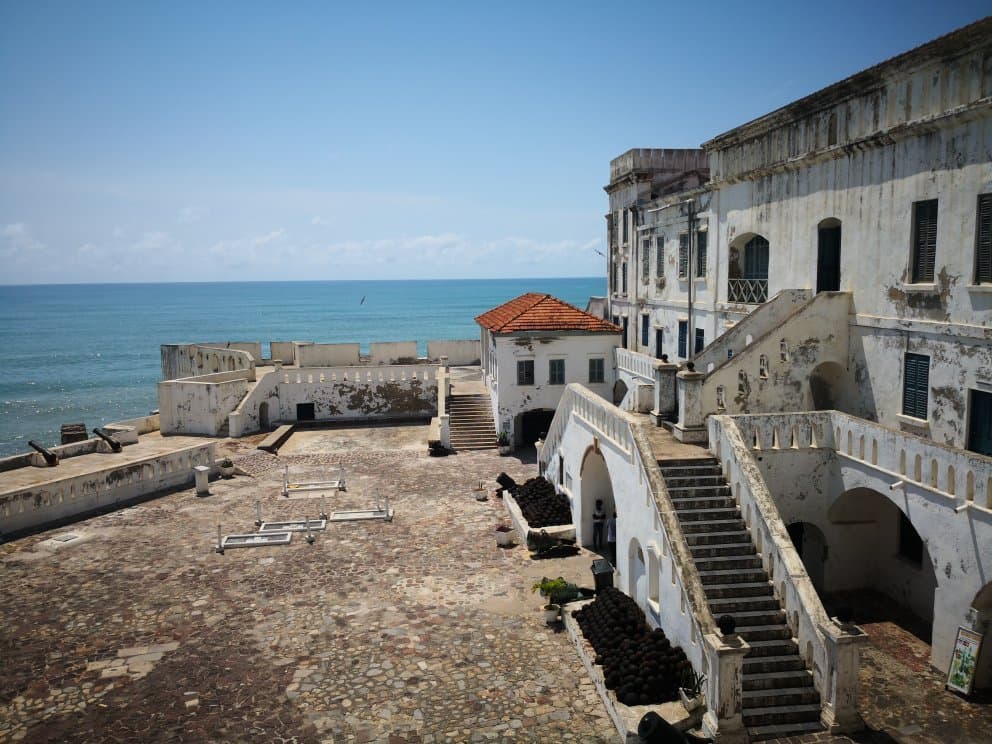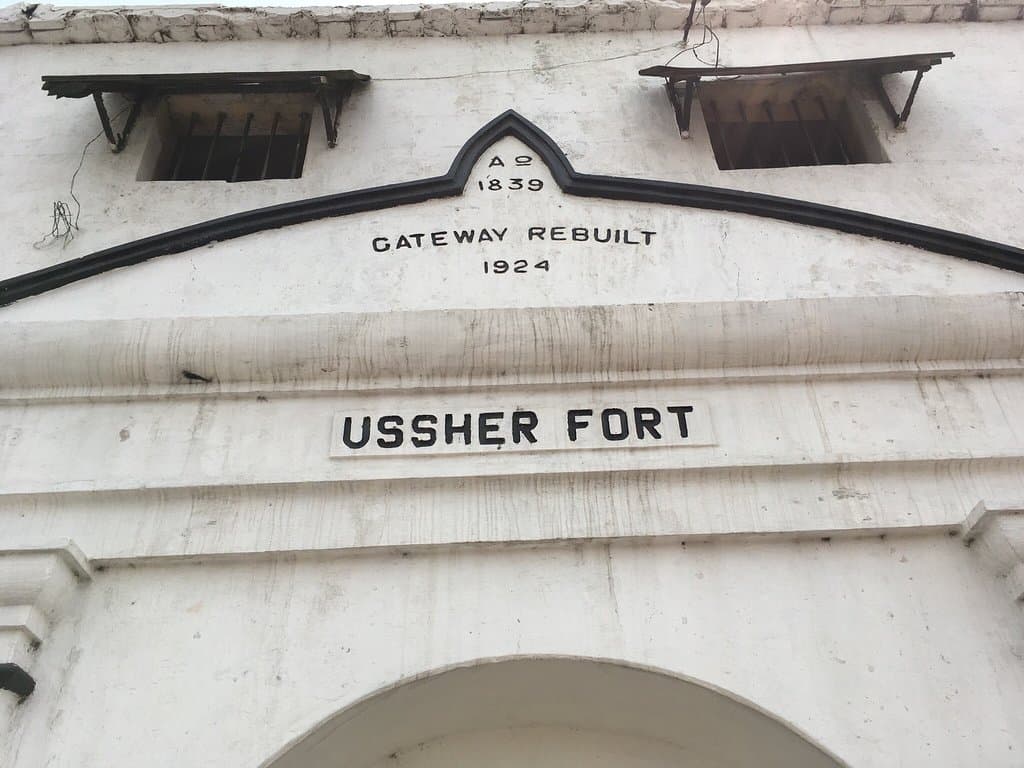
Cape Coast Castle
A powerful historical monument and UNESCO World Heritage site, Cape Coast Castle stands as a somber testament to the trans-Atlantic slave trade.

Highlights
Must-see attractions

Social
From TikTok & Reddit
Best Time
Fewer crowds, more reflective atmosphere.

Cape Coast Castle
Best Time
Fewer crowds, more reflective atmosphere.

Highlights
Must-see attractions
A powerful historical monument and UNESCO World Heritage site, Cape Coast Castle stands as a somber testament to the trans-Atlantic slave trade.
"An unforgettable journey into a significant, painful part of world history."

Wear Comfortable Shoes
You'll be doing a lot of walking on uneven surfaces. :athletic_shoe:
Allow Ample Time
Give yourself at least 2-3 hours to fully absorb the history and emotions. :clock1:

Highlights
Discover the most iconic attractions and experiences

The Door of No Return
West Wing
A somber gateway where enslaved Africans were forced onto ships, symbolizing a permanent separation from their homeland.

The Dungeons
Lower Levels
Explore the cramped, dark cells where enslaved people were held before their forced journey across the Atlantic.

Governor's Quarters
Upper Levels
Contrast the opulent living spaces of the castle's European administrators with the suffering below.

On-site Museum
Main Castle
Discover artifacts and exhibits that provide further context to the castle's role in the slave trade.
Plans like a pro.
Thinks like you
Planning Your Visit
Prepare for an Emotional Journey
Book Your Guided Tour
Best Times
Insider Tips
from TikTok, Instagram & Reddit
First time visiting Ghana (Cape Coast and Accra) in 3 weeks time
Wear Comfortable Shoes
You'll be doing a lot of walking on uneven surfaces. :athletic_shoe:
Allow Ample Time
Give yourself at least 2-3 hours to fully absorb the history and emotions. :clock1:
Have any of you all visited Door of No Return?
Cape Coast Castle – A Walk Through History
Engage with Your Guide
Guides offer invaluable insights. Ask questions and listen attentively. :microphone:
Be Prepared for Emotion
This is a place of immense historical significance and can be emotionally challenging. :pleading_face:
Best Things To Do In Accra & Cape Coast?
Tips
from all over the internet
Wear Comfortable Shoes
You'll be doing a lot of walking on uneven surfaces. :athletic_shoe:
Allow Ample Time
Give yourself at least 2-3 hours to fully absorb the history and emotions. :clock1:
Engage with Your Guide
Guides offer invaluable insights. Ask questions and listen attentively. :microphone:
Be Prepared for Emotion
This is a place of immense historical significance and can be emotionally challenging. :pleading_face:
Photography Etiquette
Be respectful when taking photos, especially in sensitive areas. :camerawithflash:
What Travellers Say
Reviews Summary
Visitors consistently describe Cape Coast Castle as a profoundly moving and essential historical experience. While the subject matter is heavy, the exceptional guided tours are frequently praised for their informative and respectful delivery, bringing the tragic history of the slave trade to life. The castle's architecture and its poignant 'Door of No Return' leave a lasting impact.
"It feels strange rating a slave castle, but I am grateful for the opportunity to visit and experience this place. As a child of our ancestors I hope the ones lost here felt my presence as I felt theirs. To have such attrocitoes practiced in such a beautiful place is beyond comprehension. How it must have felt being able to hear the ocean, to hear home and never be able to be free in it again. We had an amazing tour guide. I will never forget this visit."
Cheryl Lawson
"Visiting Cape Coast Castle is an unforgettable journey into a significant, painful part of world history. As one of the key slave castles along Ghana's coast, it offers a sobering and deeply moving look at the transatlantic slave trade.
What I liked:
The guided tour was exceptional—informative, respectful, and emotionally compelling. The guides are knowledgeable and share the history with dignity and clarity.
Walking through the dungeons, the "Door of No Return," and the governor’s quarters puts into stark contrast the horrors of the past and the resilience of the human spirit.
The museum inside the castle is small but impactful, with artifacts, photos, and displays that give further context.
The preserved architecture of the castle, perched against the Atlantic Ocean, adds a haunting beauty to the experience.
What could be improved:
Some areas, especially the museum, could benefit from updated signage and multimedia features for a more immersive educational experience.
Facilities like the restrooms and gift shop could be upgraded to better support the number of visitors the site attracts.
Final thoughts:
Cape Coast Castle is not just a tourist attraction—it is a historical monument that educates and provokes reflection. It's a must-visit for anyone traveling to Ghana who wants to understand more about African, African Diaspora, and world history."
Perry Amporfro
"Visited both the palaces. Feels like Greece when you see that much white. Though white is the color of peace, the castle had different past that you can feel once you are inside. This used to be called “Doors of no return” for the slaves."
Akter Hossain
What People Like
What People Dislike
Frequently Asked Questions
🚇 🗺️ Getting There
The most common way is by bus from Accra's main bus terminals (like VIP or STC). The journey takes about 3-4 hours. Taxis and private car hires are also options but are more expensive. :bus: :car:
Local taxis or shared minibuses (tro-tros) are readily available and affordable for the short trip between the two castles. :taxi: :bus:
Yes, Cape Coast Castle is easily accessible by public transport within Cape Coast town. Local taxis and minibuses can take you directly to the castle. :bus: :taxi:
Cape Coast Castle is located on Victoria Road in Cape Coast, Ghana, overlooking the Atlantic Ocean. :round_pushpin:
Yes, most GPS devices and map applications will accurately direct you to Cape Coast Castle using its name or address. :iphone: :world_map:
🎫 🎫 Tickets & Entry
Cape Coast Castle is typically open daily from 9:00 AM to 4:30 PM, but it's always best to check the official Ghana Museums and Monuments Board website for the most current opening hours. :clock1:
Entrance fees vary for different visitor categories (e.g., locals, students, international tourists). It's advisable to check the latest prices on the official website or inquire upon arrival. :moneybag:
While not always mandatory, booking tickets or tours in advance is recommended, especially during peak tourist seasons, to secure your preferred time slot. :ticket:
Yes, guided tours are highly recommended and are usually included with your entrance fee or available for a small additional cost. They provide essential historical context. :microphone:
The 'Door of No Return' is a specific exit point within the castle from which enslaved Africans were forced onto ships, never to return to their homeland. It's a profoundly significant historical marker. :door:
🎫 🧭 Onsite Experience
Cape Coast Castle was one of the largest slave castles in West Africa, serving as a major departure point for enslaved Africans during the trans-Atlantic slave trade. It's a UNESCO World Heritage site. :scroll:
Expect a deeply moving and educational experience. Tours cover the dungeons, the governor's quarters, and the 'Door of No Return,' providing historical context and personal stories. :walking:
Photography is generally allowed in most outdoor areas and some interior sections, but it's crucial to be respectful and follow any specific restrictions, especially in sensitive historical areas. :camerawithflash:
Yes, basic facilities such as restrooms and a gift shop are available on-site. However, some reviews suggest they could be upgraded. :toilet: :gift:
The history of Cape Coast Castle is intrinsically linked to the trans-Atlantic slave trade, detailing its construction by Europeans and its role in the brutal commodification and transportation of African people. :book:
🍽️ 🍽️ Food & Dining
Typically, there are no full-service restaurants inside the castle itself. However, there might be small kiosks selling snacks or drinks. :coffee: :water_wave:
The town of Cape Coast offers numerous local eateries and restaurants serving Ghanaian cuisine. You can find fresh seafood and traditional dishes. :fish: :rice_bowl:
Popular dishes include Fufu, Banku, Jollof rice, and various seafood preparations. Trying local street food can also be an adventure. :planteatingfood: :bread:
It's generally advisable to check the castle's specific policies on outside food and beverages, but usually, small snacks and water are permissible. :apple: :water_bottle:
While traditional Ghanaian cuisine can be meat-heavy, many restaurants are becoming more accommodating and can prepare vegetarian or vegan dishes upon request. :leafy_green:
📸 📸 Photography
The ramparts overlooking the Atlantic Ocean, the courtyard, and the exterior architecture offer stunning photographic opportunities. The 'Door of No Return' is also a key, albeit somber, subject. :camerawithflash:
Photography inside the dungeons is often restricted or discouraged due to the sensitive nature of the site and to preserve the atmosphere. Always check for signage or ask your guide. :noentrysign: :camerawithflash:
A versatile camera with good low-light capabilities is helpful for interior shots. A wide-angle lens can capture the scale of the castle, while a standard zoom is useful for details. :camera: :lens:
Drone usage is typically prohibited at historical sites like Cape Coast Castle due to security and preservation concerns. Always check local regulations before flying. :noentrysign: :drone:
Early morning or late afternoon light can be beautiful for exterior shots, offering softer light and fewer crowds. Midday sun can be harsh. :sunrise: :city_sunset:
For Different Travelers
Tailored advice for your travel style
👨👩👧 Families with Kids
Consider booking a tour with a guide who is adept at communicating complex historical events in a way that is understandable and less overwhelming for children. Highlight the architectural aspects of the castle and the stories of survival. The museum section might offer more digestible information. Ensure you have breaks and opportunities for reflection outside the most intense areas.
🌍 Heritage Seekers & History Buffs
Beyond the castle itself, consider visiting the nearby Elmina Castle for a comparative historical perspective. Researching the history of the region and the role of these castles prior to your visit can greatly enhance the experience. Engaging with local historians or cultural centers in Cape Coast can also provide deeper insights into the enduring legacy of this period.
🚶 Solo Travelers
Embrace the opportunity for introspection. The castle's atmosphere encourages personal contemplation. You might find yourself striking up conversations with other visitors who are also moved by the experience. Allow yourself the time and space to process the emotions that arise.
Deep Dives
In-depth insights and expert knowledge
The History of Cape Coast Castle
The castle's strategic location made it a prime hub for the slave trade, facilitating the movement of thousands of Africans. Visitors can explore the dungeons where men, women, and children were kept in appalling conditions, often chained and with minimal sustenance. The infamous 'Door of No Return' is a poignant reminder of the final moments of freedom for those who were forcibly transported to the Americas. The governor's quarters, in contrast, showcase the lives of the European officials who oversaw this inhumane enterprise, highlighting the stark disparity in treatment and power.
Today, Cape Coast Castle is a UNESCO World Heritage site and a crucial educational monument. It serves as a place of remembrance, reflection, and learning, drawing visitors from around the globe who seek to understand the complexities of the slave trade and its lasting impact. The guided tours are essential for grasping the full historical narrative, offering a respectful and informative journey through this significant site.
Experiencing the 'Door of No Return'
Many visitors, particularly those of African descent, describe a powerful emotional resonance when visiting the 'Door of No Return.' It's a tangible link to their heritage and a solemn acknowledgment of the resilience of the human spirit. The experience is often described as humbling and deeply moving, prompting reflection on the enduring legacy of slavery and the importance of remembering this history.
While the experience is somber, it is also framed as an essential part of understanding the broader narrative of the slave trade. The guides at Cape Coast Castle handle this sensitive area with great respect, ensuring that the historical significance is conveyed with dignity. It’s a moment that stays with visitors long after they leave, serving as a stark reminder of the past and a call for continued awareness and reconciliation.
Navigating Cape Coast Castle: Practicalities and Etiquette
When it comes to photography, while generally permitted, visitors are urged to exercise discretion and respect. Capturing images in the dungeons or other highly sensitive areas might be restricted or discouraged. The focus should remain on respectful remembrance rather than casual tourism. Always be mindful of your surroundings and the emotional weight of the site.
Engaging with the guided tours is highly recommended. The guides are often descendants of the region and possess deep knowledge and personal connections to the history. Their narratives add a crucial layer of understanding and emotional depth to the visit, transforming it from a mere sightseeing trip into a profound educational experience.





Social
from TikTok, Instagram & Reddit